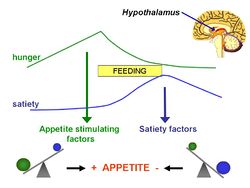Poverty and obesity: Difference between revisions
Jump to navigation
Jump to search

imported>Ross McEwan No edit summary |
imported>Hannah Harman No edit summary |
||
| Line 2: | Line 2: | ||
{{subpages}} | {{subpages}} | ||
{{Image|Appetite.jpg|right|250px}} | {{Image|Appetite.jpg|right|250px}} | ||
==Introduction== | |||
'''Poverty and obesity''' are very closely linked. In the USA, the highest rates of [[obesity]] occur in the poorest population groups. Poverty is associated with lower expenditure on food, and low consumption of fruit and vegetables, and energy-dense foods represent the lowest-cost option for consumers. However, the high energy density and palatability of sweets and fats are associated with higher energy intakes. <ref>Drewnowski A, Specter SE (2004) Poverty and obesity: the role of energy density and energy costs ''Am J Clin Nutr'' 79:6-16 PMID 14684391</ref> | '''Poverty and obesity''' are very closely linked. In the USA, the highest rates of [[obesity]] occur in the poorest population groups. Poverty is associated with lower expenditure on food, and low consumption of fruit and vegetables, and energy-dense foods represent the lowest-cost option for consumers. However, the high energy density and palatability of sweets and fats are associated with higher energy intakes. <ref>Drewnowski A, Specter SE (2004) Poverty and obesity: the role of energy density and energy costs ''Am J Clin Nutr'' 79:6-16 PMID 14684391</ref> | ||
==Diet Quality== | |||
==Dietary Energy Density== | |||
==Energy Costs== | |||
==References== | ==References== | ||
{{reflist | 2}} | {{reflist | 2}} | ||
Revision as of 10:04, 20 October 2011
For the course duration, the article is closed to outside editing. Of course you can always leave comments on the discussion page. The anticipated date of course completion is 01 April 2012. One month after that date at the latest, this notice shall be removed. Besides, many other Citizendium articles welcome your collaboration! |
Introduction
Poverty and obesity are very closely linked. In the USA, the highest rates of obesity occur in the poorest population groups. Poverty is associated with lower expenditure on food, and low consumption of fruit and vegetables, and energy-dense foods represent the lowest-cost option for consumers. However, the high energy density and palatability of sweets and fats are associated with higher energy intakes. [1]
Diet Quality
Dietary Energy Density
Energy Costs
References
- ↑ Drewnowski A, Specter SE (2004) Poverty and obesity: the role of energy density and energy costs Am J Clin Nutr 79:6-16 PMID 14684391
